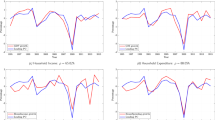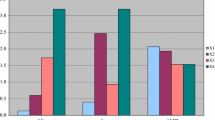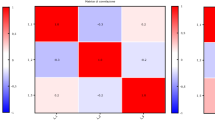Abstract
In recent decades, the role of gross domestic product (GDP) as an indicator of well-being has been sharply questioned by both researchers and institutions. This theoretical discussion leads to the international debate “Beyond GDP”, which aims to assess the progress of a country considering fundamental social and environmental dimensions of well-being, inequality, and sustainability. According to this perspective, well-being and quality of life, in general, deserve great attention at the institutional level; hence, this topic attracted the consideration of methodological researchers, and thus many statistical indicators have been proposed. Recently, most insiders have dealt with the problem of the multidimensionality of well-being, and many research has also stressed the importance of assessing trends and changes over time rather than observing indices in single instants. For this reason, this research proposes the use of functional data analysis to build new social indicators of well-being and to interpret them considering the original time observations as a continuous function. Indeed, repeated measures of social indicators of well-being can be considered as functions in the time domain. Moreover, this approach adds to the existing techniques interesting instruments of analysis, e.g. the derivatives and the functional principal components, and overcomes some strong assumptions of the time series analysis. To demonstrate the appropriateness of this approach, this study proposes an application to real data concerning “subjective well-being” within the Italian “BES project” The final aim of this research is to provide scholars and policy-makers with additional tools for assessing the “Equitable and Sustainable Well-being” over time.














Similar content being viewed by others
Notes
Focusing on the case of an Hilbert space with a metric \(d(\cdot ,\cdot )\) associated with a norm so that \(d(x_1(t), x_2 (t)) = \Vert x_1(t) - x_2(t)\Vert\), and where the norm \(\Vert \cdot \Vert\) is associated with an inner product \(\langle \cdot ,\cdot \rangle\) so that \(\Vert x(t)\Vert =\langle x(t),x(t) \rangle ^{1/2}\), we can obtain as specific case the space \(L_2[a,b]\) of real square-integrable functions defined on [a, b] by \(\langle x_1(t),x_2(t) \rangle =\int _{a}^{b} x_1(t)x_2(t)dt\).
Some examples of classical statistical concepts adapted to the FDA framework are: the functional mean \(\overline{x}(t)=\frac{1}{N}\sum _{i=1}^N x_i(t)\), functional variance \(\sigma ^2_x(t)=\frac{1}{N}\sum _{i=1}^N\Bigl (\widehat{x}_i(t)-\overline{x}(t)\Bigr )^2\), functional covariance \(\sigma (s,t)=cov\Bigl (x(s),x(t)\Bigr )=\frac{1}{n}\sum _{i=1}^n \Bigl (x_i(s)-\overline{x}(s)\Bigr )\Bigl (x_i(t)-\overline{x}(t)\Bigr )\), and functional correlation \(\rho (s,t)=\frac{\sigma (s,t)}{\sqrt{\sigma (s,s)}\sqrt{(\sigma (t,t)}}\).
References
Aguilera, A., & Aguilera-Morillo, M. (2013). Penalized PCA approaches for b-spline expansions of smooth functional data. Applied Mathematics and Computation, 219, 7805–7819. https://doi.org/10.1016/j.amc.2013.02.009.
Aguilera, A., Aguilera-Morillo, M.C., Escabias, M., & Valderrama, M. (2011). Penalized spline approaches for functional principal component logit regression. In F. Ferraty (Ed.), Contributions to statistics (pp. 1–7). Heidelberg: Physica-Verlag. https://doi.org/10.1007/978-3-7908-2736-1_1.
Alkire, S. (2015). Capability approach and well-being measurement for public policy. OPHI working paper 94.
Andrews, F. M. (1983). Population issues and social indicators of well-being. Population and Environment, 6, 210–230. https://doi.org/10.1007/bf01363887.
Andrews, F. M., & Withey, S. B. (1976). Social indicators of well-being. New York: Springer. https://doi.org/10.1007/978-1-4684-2253-5.
Betti, G. (2016). Fuzzy measures of quality of life: A multidimensional and comparative approach. International Journal of Uncertainty, Fuzziness and Knowledge-Based Systems, 24, 25–37. https://doi.org/10.1142/s021848851640002x.
Betti, G., Cheli, B., Lemmi, A., & Verma, V. (2006). Multidimensional and longitudinal poverty: An integrated fuzzy approach. In A. Lemmi & G. Betti (Eds.), Fuzzy set approach to multidimensional poverty measurement (pp. 115–137). New York: Springer. https://doi.org/10.1007/978-0-387-34251-1_7.
Biswas-Diener, R., Diener, E., & Tamir, M. (2004). The psychology of subjective well-being. Daedalus, 133, 18–25. https://doi.org/10.1162/001152604323049352.
Boccuzzo, G., & Caperna, G. (2017). Evaluation of life satisfaction in Italy: Proposal of a synthetic measure based on poset theory. In F. Maggino (Ed.), Complexity in society: From indicators construction to their synthesis (pp. 291–321). Cham: Springer. https://doi.org/10.1007/978-3-319-60595-1_12.
Boelhouwer, J., & Bijl, R. (2015). Long-term trends in quality of life: An introduction. Social Indicators Research, 130, 1–8. https://doi.org/10.1007/s11205-015-1132-1.
Callens, M. (2015). Long term trends in life satisfaction, 1973–2012: Flanders in Europe. Social Indicators Research, 130, 107–127. https://doi.org/10.1007/s11205-015-1134-z.
Cardot, H., Ferraty, F., & Sarda, P. (1999). Functional linear model. Statistics & Probability Letters, 45, 11–22. https://doi.org/10.1016/s0167-7152(99)00036-x.
Cuevas, A. (2014). A partial overview of the theory of statistics with functional data. Journal of Statistical Planning and Inference, 147, 1–23. https://doi.org/10.1016/j.jspi.2013.04.002.
Cummins, R. A. (2018). Subjective wellbeing as a social indicator. Social Indicators Research,. https://doi.org/10.1007/s11205-016-1496-x.
Cutler, D. M. (2009). Measuring national well-being. In A. B. Krueger (Ed.), Measuring the subjective well-being of nations (pp. 107–112). Chicago: University of Chicago Press. https://doi.org/10.7208/chicago/9780226454573.003.0004.
Davino, C., Dolce, P., Taralli, S., & Vinzi, V. E. (2016). A quantile composite-indicator approach for the measurement of equitable and sustainable well-being: A case study of the italian provinces. Social Indicators Research,. https://doi.org/10.1007/s11205-016-1453-8.
Di Battista, T., Fortuna, F., & Maturo, F. (2017). BioFTF: An R package for biodiversity assessment with the functional data analysis approach. Ecological Indicators, 73, 726–732. https://doi.org/10.1016/j.ecolind.2016.10.032.
di Bella, E., Corsi, M., Leporatti, L., & Cavalletti, B. (2016). Wellbeing and sustainable development: A multi-indicator approach. Agriculture and Agricultural Science Procedia, 8, 784–791. https://doi.org/10.1016/j.aaspro.2016.02.068.
Di Spalatro, D., Maturo, F., & Sicuro, L. (2017). Inequalities in the provinces of Abruzzo: A comparative study through the indices of deprivation and principal component analysis (pp. 219–231). Cham: Springer. https://doi.org/10.1007/978-3-319-54819-7_15.
Diener, E. (Ed.) (2009). Conclusion: Future directions in measuring well-being. In Assessing well-being (pp. 267–274). Netherlands: Springer. https://doi.org/10.1007/978-90-481-2354-4_13.
Diener, E., Diener, M., & Diener, C. (1995). Factors predicting the subjective well-being of nations. Journal of Personality and Social Psychology, 69, 851–864. https://doi.org/10.1037/0022-3514.69.5.851.
Easterlin, R. A., & Switek, M. (2014). Set point theory and public policy. In K. Sheldon & R. E. Lucas (Ed.), Stability of happiness (pp. 201–217). Amsterdam: Elsevier.
Escabias, M., Aguilera, A. M., & Aguilera-Morillo, M. C. (2014). Functional PCA and base-line logit models. Journal of Classification, 31, 296–324. https://doi.org/10.1007/s00357-014-9162-y.
Fattore, M. (2015). Partially ordered sets and the measurement of multidimensional ordinal deprivation. Social Indicators Research, 128, 835–858. https://doi.org/10.1007/s11205-015-1059-6.
Fattore, M., & Arcagni, A. (2014). PARSEC: An R package for poset-based evaluation of multidimensional poverty. In R. Brüggemann, L. Carlsen & J. Wittmann (Eds.), Multi-indicator systems and modelling in partial order (pp. 317–330). New York: Springer. https://doi.org/10.1007/978-1-4614-8223-9_15.
Fattore, M., & Arcagni, A. (2016). A reduced posetic approach to the measurement of multidimensional ordinal deprivation. Social Indicators Research, 136, 1053–1070. https://doi.org/10.1007/s11205-016-1501-4.
Fattore, M., & Maggino, F. (2017). Some considerations on well-being evaluation procedures, taking the cue from “exploring multidimensional well-being in switzerland: Comparing three synthesizing approaches”. Social Indicators Research,. https://doi.org/10.1007/s11205-017-1634-0.
Fattore, M., Maggino, F., & Arcagni, A. (2016). Non-aggregative assessment of subjective well-being. In G. Alleva & A. Giommi (Eds.), Topics in theoretical and applied statistics (pp. 227–237). Cham: Springer. https://doi.org/10.1007/978-3-319-27274-0_20.
Febrero-Bande, M., & de la Fuente, M. (2012). Statistical computing in functional data analysis: The R package fda.usc. Journal of Statistical Software, 51, 1–28. https://doi.org/10.18637/jss.v051.i04.
Felice, E. (2017). The roots of a dual equilibrium: GDP, productivity and structural change in the italian regions in the long-run (1871–2011). SSRN Electronic Journal,. https://doi.org/10.2139/ssrn.3082184.
Ferraty, F. (2011). Recent advances in functional data analysis and related topics. Heidelberg: Physica-Verlag. https://doi.org/10.1007/978-3-7908-2736-1.
Ferraty, F., & Vieu, P. (2003). Curves discrimination: A nonparametric functional approach. Computational Statistics & Data Analysis, 44, 161–173. https://doi.org/10.1016/s0167-9473(03)00032-x.
Ferraty, F., & Vieu, P. (2006). Nonparametric functional data analysis. New York: Springer. https://doi.org/10.1007/0-387-36620-2.
Fortuna, F., & Maturo, F. (2018). K-means clustering item characteristic curves and item information curves via functional principal component analysis. Quality & Quantity,. https://doi.org/10.1007/s11135-018-0724-7.
Gattone, S., & Di Battista, T. (2009). A functional approach to diversity profiles. Journal of the Royal Statistical Society: Series C (Applied Statistics), 58, 267–284. https://doi.org/10.1111/j.1467-9876.2009.00646.x.
Headey, B., & Wearing, A. (1989). Personality, life events, and subjective well-being: Toward a dynamic equilibrium model. Journal of Personality and Social Psychology, 57, 731–739. https://doi.org/10.1037/0022-3514.57.4.731.
Iglesias, K., Suter, C., Beycan, T., & Vani, B. P. (2016). Exploring multidimensional well-being in switzerland: Comparing three synthesizing approaches. Social Indicators Research, 134, 847–875. https://doi.org/10.1007/s11205-016-1452-9.
ISTAT. (2016). Rapporto bes 2016: il benessere equo e sostenibile in italia. https://www.istat.it/it/files/2016/12/BES-2016.pdf.
Kuentz-Simonet, V., Labenne, A., & Rambonilaza, T. (2016). Using ClustOfVar to construct quality of life indicators for vulnerability assessment municipality trajectories in southwest france from 1999 to 2009. Social Indicators Research, 131, 973–997. https://doi.org/10.1007/s11205-016-1288-3.
Lee, S.J. & Kim, Y. (2016). Structure of well-being: An exploratory study of the distinction between individual well-being and community well-being and the importance of intersubjective community well-being. In Y. Kee, S. J. Lee & R. Phillips (Eds.), Social factors and community well-being (pp. 13–37). Cham: Springer. https://doi.org/10.1007/978-3-319-29942-6_2.
Lykken, D., & Tellegen, A. (1996). Happiness is a stochastic phenomenon. Psychological Science, 7, 186–189. https://doi.org/10.1111/j.1467-9280.1996.tb00355.x.
Maggino, F. (2014). Multi-indicator measures. In Encyclopedia of quality of life and well-being research (pp. 4193–4194). Netherlands: Springer. https://doi.org/10.1007/978-94-007-0753-5_1876.
Maggino, F., & Facioni, C. (2015). Measuring stability and change: Methodological issues in quality of life studies. Social Indicators Research, 130, 161–187. https://doi.org/10.1007/s11205-015-1129-9.
Maria, K. (2009). The effects of maternal deprivation on behavioural, neurochemical and neurobiological indices related to dopaminergic activity. Frontiers in Behavioral Neuroscience,. https://doi.org/10.3389/conf.neuro.08.2009.09.275.
Maturo, F. (2018). Unsupervised classification of ecological communities ranked according to their biodiversity patterns via a functional principal component decomposition of Hill’s numbers integral functions. Ecological Indicators, 90, 305–315. https://doi.org/10.1016/j.ecolind.2018.03.013.
Maturo, F., & Di Battista, T. (2018). A functional approach to hill’s numbers for assessing changes in species variety of ecological communities over time. Ecological Indicators, 84, 70–81. https://doi.org/10.1016/j.ecolind.2017.08.016.
Maturo, F., Fortuna, F., & Di Battista, T. (2018a). Testing equality of functions across multiple experimental conditions for different ability levels in the IRT context: The case of the IPRASE TLT 2016 survey. Social Indicators Research,. https://doi.org/10.1007/s11205-018-1893-4.
Maturo, F., Migliori, S., & Paolone, F. (2017). Do institutional or foreign shareholders influence national board diversity? Assessing board diversity through functional data analysis. In Š. Hošková-Mayerová, F. Maturo & J. Kacprzyk (Eds.), Mathematical-statistical models and qualitative theories for economic and social sciences, (pp. 199–217). Cham: Springer. https://doi.org/10.1007/978-3-319-54819-7_14.
Maturo, F., Migliori, S., & Paolone, F. (2018b). Measuring and monitoring diversity in organizations through functional instruments with an application to ethnic workforce diversity of the U.S. Federal agencies. Computational and Mathematical Organization Theory,. https://doi.org/10.1007/s10588-018-9267-7.
Mauro, V., Biggeri, M., & Maggino, F. (2016). Measuring and monitoring poverty and well-being: A new approach for the synthesis of multidimensionality. Social Indicators Research, 135, 75–89. https://doi.org/10.1007/s11205-016-1484-1.
Michalos, A. (2008). Education, happiness and wellbeing. Social Indicators Research: An International and Interdisciplinary Journal for Quality-of-Life Measurement, 87, 347–366.
Mushongera, D., Zikhali, P., & Ngwenya, P. (2015). A multidimensional poverty index for gauteng province, South Africa: Evidence from quality of life survey data. Social Indicators Research, 130, 277–303. https://doi.org/10.1007/s11205-015-1176-2.
OECD. (2011). How's Life?: Measuring Well-being. Paris: OECD Publishing. https://doi.org/10.1787/9789264121164-en.
OECD. (2013). OECD guidelines on measuring subjective well-being. Measuring subjective well-being (pp. 139–178). https://doi.org/10.1787/9789264191655-7-en.
OECD. (2014). GDP as a welfare metric: The beyond GDP agenda. https://doi.org/10.1787/9789264214637-16-en.
Otoiu, A., Titan, E., & Dumitrescu, R. (2014). Are the variables used in building composite indicators of well-being relevant? Validating composite indexes of well-being. Ecological Indicators, 46, 575–585. https://doi.org/10.1016/j.ecolind.2014.07.019.
Ramsay, J., & Dalzell, C. (1991). Some tools for functional data analysis. Journal of the Royal Statistical Society: Series B (Methodological), 53, 539–561.
Ramsay, J., Hooker, G., & Graves, S. (Eds.) (2009). Introduction to functional data analysis. In Functional data analysis with R and MATLAB (pp. 1–19). New York: Springer. https://doi.org/10.1007/978-0-387-98185-7_1.
Ramsay, J., & Silverman, B. (2005). Functional data analysis (2nd ed.). New York: Springer.
Ramsay, J. O., & Silverman, B. W. (Eds.). (2002). Applied functional data analysis: Methods and case studies. New York: Springer. https://doi.org/10.1007/b98886.
Rogge, N., & Van Nijverseel, I. (2018). Quality of life in the european union: A multidimensional analysis. Social Indicators Research,. https://doi.org/10.1007/s11205-018-1854-y.
Rojas, M. (2018). Indicators of people’s well-being. Social Indicators Research,. https://doi.org/10.1007/s11205-016-1507-y.
Rosa, P. D., Nicolau, B., Brodeur, J. M., Benigeri, M., Bedos, C., & Rousseau, M. C. (2010). Associations between school deprivation indices and oral health status. Community Dentistry and Oral Epidemiology, 39, 213–220. https://doi.org/10.1111/j.1600-0528.2010.00592.x.
Sen, A. (1979). Utilitarianism and welfarism. The Journal of Philosophy, 76, 463–489.
Sen, A. (1980). Equality of what?. Cambridge: Cambridge University Press. Reprinted in John Rawls et al., Liberty, equality and law (Cambridge: Cambridge University Press, 1987).
Shang, H. (2013). A survey of functional principal component analysis. AStA Advances in Statistical Analysis, 98, 121–142. https://doi.org/10.1007/s10182-013-0213-1.
Sheldon, K. M., & Lucas, R. E. (2014a). Is it possible to become a permanently happier person?. In K. Sheldon & R. E. Lucas (Eds.), Stability of happiness (pp. 1–7). Elsevier. https://doi.org/10.1016/b978-0-12-411478-4.00001-1.
Sheldon, K. M., & Lucas, R. E. (2014b). Preface. In K. Sheldon & R. E. Lucas (Eds.), Stability of happiness (pp. xv–xvi). Elsevier. https://doi.org/10.1016/b978-0-12-411478-4.00018-7.
Stiglitz, J. E., Sen, A. K., & Fitoussi, J. P. (2009). Report by the commission on the measurement of economic performance and social progress. Technical report.
Suter, C., & Iglesias, K. (2005). Relative deprivation and well-being: Switzerland in a comparative perspective. In H. Kriesi, P. Farago, M. Kohli & M. Zarin-Nejadan (Eds.), Contemporary Switzerland (pp. 9–37). UK: Palgrave Macmillan. https://doi.org/10.1057/9780230523586_2.
Veenhoven, R. (2007). Subjective measures of well-being. In M. McGillivray (Ed.), Human well-being (pp. 214–239). UK: Palgrave Macmillan. https://doi.org/10.1057/9780230625600_9.
Zhao, X., Marron, J., & Wells, M. (2004). The functional data analysis view of longitudinal data. Statistica Sinica, 14, 789–808.
Author information
Authors and Affiliations
Corresponding author
Additional information
Publisher's Note
Springer Nature remains neutral with regard to jurisdictional claims in published maps and institutional affiliations.
Rights and permissions
About this article
Cite this article
Maturo, F., Balzanella, A. & Di Battista, T. Building Statistical Indicators of Equitable and Sustainable Well-Being in a Functional Framework. Soc Indic Res 146, 449–471 (2019). https://doi.org/10.1007/s11205-019-02137-5
Accepted:
Published:
Issue Date:
DOI: https://doi.org/10.1007/s11205-019-02137-5




